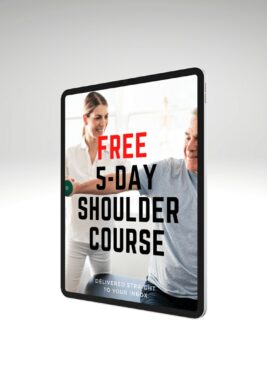Learn
Scapular Alignment | Scapular Dyskinesis Assessment
The literature commonly describes normal shoulder girdle alignment with the following criteria.
Shoulder height lies slightly below the level of spinous process T1 and if viewed from the side the plumb line runs centrally through the acromion.
Impaired alignment of the shoulder girdle can manifest as elevation, which can be seen from behind, or depression when the superior angle of the scapula lies below T2, or when looking at the patient from the front showing in a more horizontal orientation of the clavicle or an AC joint that lies below the SC joint.
Thirdly, an increasingly more prevalent misalignment is that of a protracted shoulder girdle.
Normal scapula position usually consists of the superior angle being at spinal level T2 and the inferior angle at T7.
The medial border runs parallel to the spine at a distance of 3 inches of 7,5cm, which is roughly the width of four fingers.
The Scapula lies flat on the thorax with a 30° anterior rotation to the frontal plane.
The scapula has four possible movement directions. (O’Leary et al 2015):

Muscles attaching around the scapula:
- M.trapezius & M.serratus anterior = force couple
- descendens & pars inferior Serratus: upward rotation
- ascendens: upward into caudomedial direction (posterior tilt)
- transversa: adduction
- pars superior Serratus = antagonist to pars inferior
- M.levator scapulae:
- downward rotation & cranial medial
- Mm.rhomboidei:
- downward rotation & adduction
- M. pectoralis minor:
- downward rotation & anterior tilt
Deficiencies or overactivity in one or more of these muscles can lead to impaired alignment.
In a downward rotated scapula, the inferior angle will be positioned more medial to the spine than the superior angle. Oftentimes, this is caused by a shortened levator and/or rhomboid muscle with or without a lengthened trapezius pars descendens and maybe also serratus anterior weakness.

If the scapula is depressed so it is positioned below the common area between T2-7 the reason might be a shortened pectoralis major or latissimus dorsi and or a lengthed trapezius pars descendens.

A more elevated scapula can have multiple causes. If just the superior angle lies above the AC joint, the reason might be a short levator scapula.

If the AC joint is elevated as well then the trapezius pas descendens might be more involved.

If the entire scapular spine is elevated then the above plus rhomboids might all be shortened.

In increased adduction, meaning the distance between the spine and the medial border is smaller than 3 inches or 7,6cm, possible reasons for the misalignment could be shortened rhomboids or trapezius pars descendens, or a lengthened/weak serratus anterior-

On the other hand, if the scapula presents more abducted showing a more anteriorly oriented glenoid and a distance between the spine and medial border larger than 3inches the cause can be a shortened serratus anterior and/or pectoralis major.

In these pictures, you can see a winging scapula or scapula alata. The medial border is very prominent and lifts off of the thorax. Often times weakness of the serratus anterior can be caused by a compromised long thoracic nerve. Furthermore, a flat thoracic spine or hyperkyphosis, scoliosis, and hypertrophy of the subscapularis might be reasons for a winging scapula.

When the inferior angle of the scapula lifts off of the thorax we are talking about a tilted or tipped scapula. Predominantly, shortened muscles attaching to the coracoid process like the pectoralis minor, the short head of the biceps brachii, or coracobrachialis can cause a tilt.

Here’s an overview about the impairments and possible causes:

TWO MYTHS BUSTED & 3 KNOWLEDGE BOMBS FOR FREE

If you’re curious about further tests to assess the scapula, check out the following:
- Scapulohumeral Rhythm
- Scapular Dyskinesis Test
- Scapular Assistance Test (SAT)
- Scapular Resistance Test (SRT)
References
Like what you’re learning?
BUY THE FULL PHYSIOTUTORS ASSESSMENT BOOK
- 600+ Pages e-Book
- Interactive Content (Direct Video Demonstration, PubMed articles)
- Statistical Values for all Special Tests from the latest research
- Available in 🇬🇧 🇩🇪 🇫🇷 🇪🇸 🇮🇹 🇵🇹 🇹🇷
- And much more!








